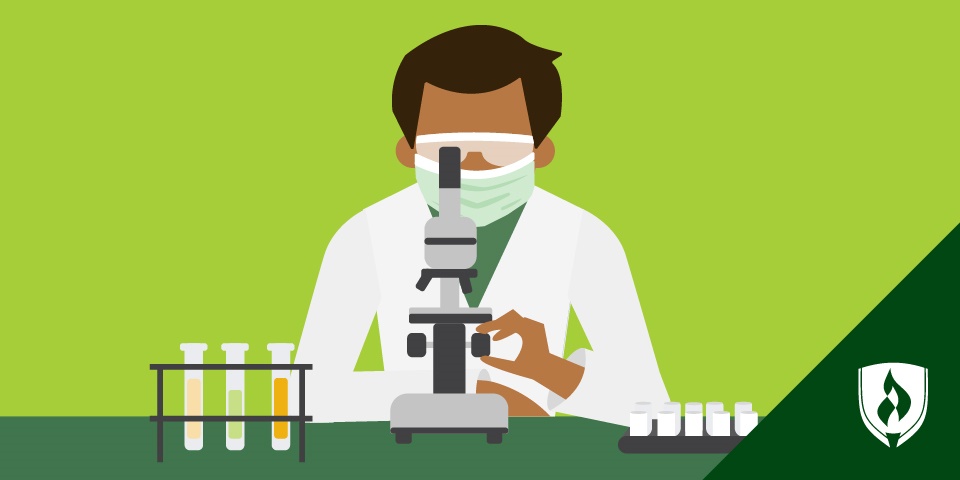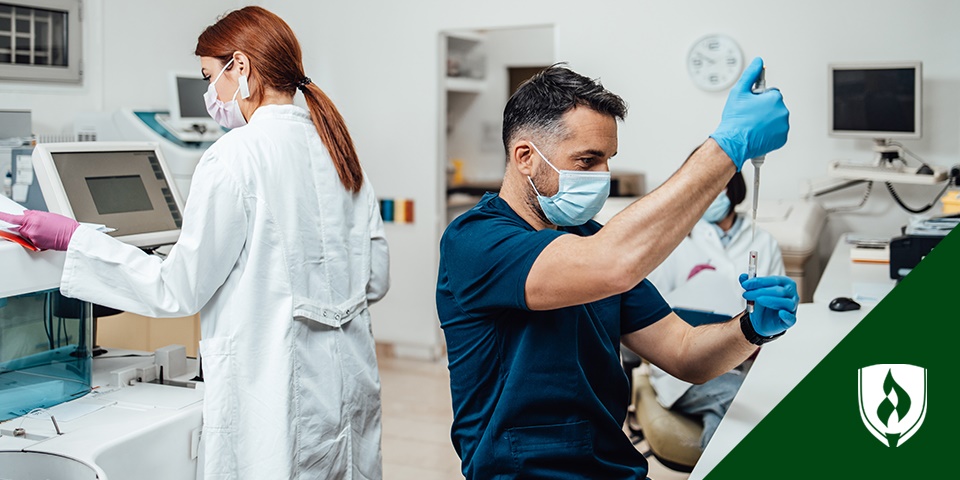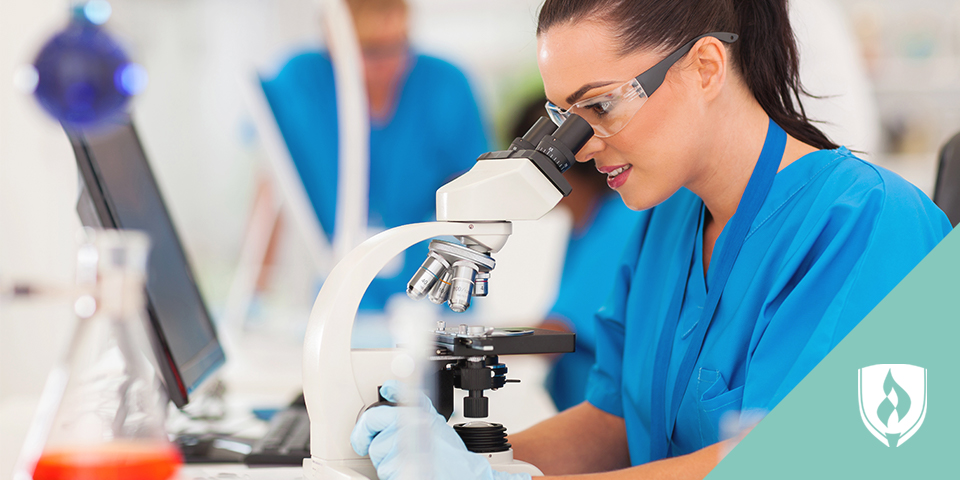
Many of us remember our first day in a second language class. The teacher walks in, introduces themselves and begins a soliloquy in this language you are about to spend months learning—and you sit there wondering, “What have I gotten myself into?”
This feeling isn’t reserved solely for bleary-eyed kids suddenly regretting their choice of electives. Practically anyone learning the ropes of a new subject can feel a bit overwhelmed with the abundance of new terms, tools and abbreviations they’re encountering. That’s certainly the case for anyone looking to familiarize themselves with medical lab terminology.
The good news? Every single lab professional has started exactly where you are now—that means you can do it too. With a little familiarization, you can start your education a few steps ahead of the curve. To help you get started, we’ve compiled an assortment of 30 basic terms and abbreviations that you’ll come across in a medical lab.
30 Common medical lab terms and acronyms to know
Ready to get a head start on learning lab lingo? Try your hand at getting these common medical lab terms, acronyms and tools mentally locked down.
1. Cell morphology
This refers to the form, size and shape, and structure of a cell—all of the visually recognizable characteristics.
2. CBC
“Complete blood count” is the acronym used to describe the basic blood test that looks at your white blood cells, red blood cells and platelets. This can be used to detect a variety of diseases and health disorders.
3. Immunohematology
Immunohematology is the study of blood and blood-forming tissue in relation to the body’s immune response. Laboratory technicians can specialize in this field.
4. A-Fib
Short for “atrial fibrillation,” this condition is something you may have heard on a medical drama (or during its commercial breaks). It simply refers to a disturbance or irregularity in the rhythm of the heart—most commonly beating too fast.
5. Cytotechnologist
Another specific field for a medical technician, a cytotechnologist is someone who is trained in the identification of cells and cellular abnormalities, oftentimes specializing in identifying different kinds of cancer.
6. IDDM and hemoglobin A1c
IDDM, “Insulin-dependent diabetes mellitus,” is the acronym for type 1 diabetes in which patients have little or no ability to produce insulin. Hemoglobin A1c is the test used to measure the glucose in the body to determine how well a patient is managing their diabetes.
7. Agglutination viewer
An agglutination viewer is a piece of medical equipment found in many advanced labs. Agglutination refers to particles clumping together, so this piece of equipment provides a magnified view of blood to observe the agglutination process.
8. ACE
Angiotensin-converting enzymes (ACE) are most commonly connected with drugs called ACE inhibitors. You might have heard of this phrase, as these drugs are used to treat things like high blood pressure, heart failure, diabetes and kidney disease.
9. Radiotherapy
Radiotherapy is a cancer treatment that uses high doses of radiation to kill cancer cells or shrink tumors.
10. RT, RTx, XRT
Acronyms for the term radiotherapy—the “x” is for X-ray.
11. Cell washer
A special-purpose machine used to wash away any kind of cellular debris. These are most often used to “wash” donor blood to ensure that the blood is compatible with the blood of the recipient.
12. SOB
If you see this in medical lab paperwork, know that it’s not an assessment of a patient’s character—it’s a common medical abbreviation for “shortness of breath”.
13. Bench refractometer
A piece of lab equipment that is used for measuring the refractive index of gases, liquids and translucent solids. In other words, refractometers determine the chemical composition of the substance it is measuring.
14. QID
“Quarter in die” is a Latin phrase that is found on prescriptions that refer to taking the dose four times in a day.
15. Heterologous
Meaning “of a different organism or species.” This concept can be applied in a variety of ways in biological science. For example, tissue samples may be analyzed for heterologous cells that may indicate development of a tumor.
16. CRP
“C-reactive protein” is a protein produced by the liver. High concentrations of it in blood is an indicator of inflammation issues.
17. Hypodermic
A term most commonly heard in connection with “needle,” hypodermic means relating to the parts beneath the skin. A hypodermic needle is then used when an injection is needed beneath the skin.
18. NSAID
“Non-steroidal anti-inflammatory drug” is the acronym that you will find associated with drugs like ibuprofen.
19. Anaerobe
An organism or bacteria that does not require air or more precisely, oxygen, to live. It is contrasted with an aerobe that does require those things to live.
20. HGB
The acronym for hemoglobin—the protein inside red blood cells that carry oxygen from the lungs to tissues and organs, and then carries carbon dioxide back to the lungs.
21. Hematocrit test (HCT)
A common blood test that measures the proportion of red blood cells found within the sample. This test is used to check for conditions such as anemia, dehydration, malnutrition and leukemia.
22. Comorbid
The condition of having two or more diseases at the same time—most commonly heard when someone is described as having multiple comorbidities.
23. ESR
“Erythrocyte sedimentation rate” is a type of blood test used to detect inflammation. Erythrocytes are made in the bone marrow and contain hemoglobin.
24. Glomerular disease
A glomerular is a tiny structure in the kidney that filters the blood from the urine. When this structure is damaged, proteins or blood can leak into the urine.
25. GFR
“Glomerular filtration rate” is the acronym for a test that is done to access the extent of potential kidney damage.
26. Colorimeter
A piece of medical lab equipment that can be used to detect color changes to help identify which antigens are triggering specific disease responses.
27. CVA
“Cerebrovascular accident” refers to an issue in the brain (cerebro) regarding the veins and arteries (vascular)—commonly referred to as a stroke.
28. Electrocardiogram/Echocardiogram
Two tests that use electrical impulses and sound waves respectively to look at a heart.
29. DTP
A common vaccine that is used against three diseases: diphtheria, tetanus and pertussis
30. Basic Metabolic Panel (BMP)
Refers to a series of tests that are done to evaluate the overall function and health of your kidneys by specifically looking at the electrolytes in your blood.
The first steps to your career in the medical field
There is a famous adage that says every journey begins with a single step. You’ve now taken this first step by just doing the basic work of understanding some new vocabulary, whether or not you can remember these terms perfectly. You can learn more about your next steps by reading “How to Become a Medical Laboratory Technician”.




